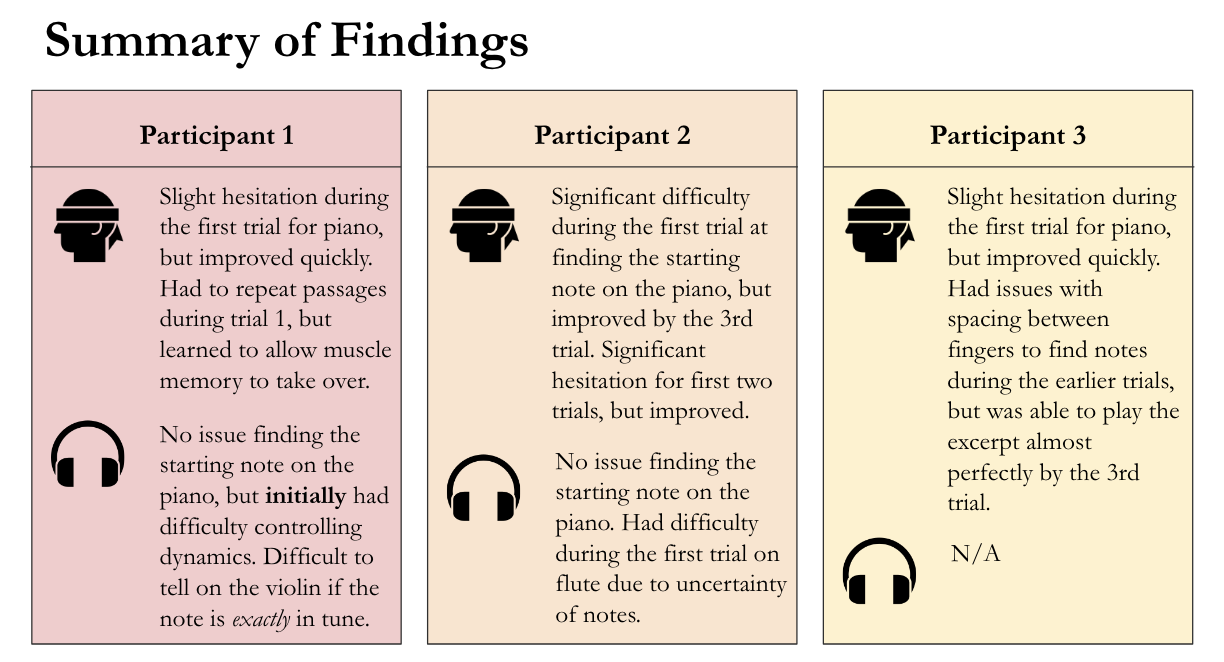Project Introduction
For musicians, hearing and sight are often seen as vital senses that are needed to even begin learning how to play an instrument.
Problem
There is little research on how an experienced musician may adapt to a sudden disability such as hearing loss and blindness.
Project Description
Knowing that many musicians feel compelled to retire once they begin to lose their hearing or eyesight, I wanted to see how experienced musicians may react playing-wise to one of their senses (either hearing or eyesight) being diminished. Below, I'll summarize some of my main observations as well as some points I found interesting. If you're interested in learning more, feel free to check out the full paper here!!
Cognitive Analysis
Prediction
The loss of sight will affect playing the correct notes on the piano and percussion instruments, while loss of hearing will significantly affect even the most basic abilities when playing the violin and other stringed instruments that can easily go out-of-tune. The loss of hearing will also affect musicality significantly for all instruments.
Analysis Protocol
I observed how 3 experienced musicians adapted to playing their instruments fist without sight (through the use of blindfolds), then with hearing loss (through the use of headphones). Specifically, I focused on the new methods each musician used in order to adapt to their changed environment.

Experiment


Conclusion
While the power law evidently comes into play for vision loss in piano, it was not observed for all instruments for hearing loss. This can be seen from the improvements that were made between Trials 1 and 3 when the participants were blindfolded, and the lack of improvement between trials when the participants were wearing headphones. Most participants did not seem to be very affected by vision loss in instruments aside from piano as predicted in the interviews, suggesting that for experienced musicians aside from pianists, vision loss may not be difficult to overcome in their playing.
From the three trials observed for piano, it seems that there is a definite learning curve (since only three trials were conducted, only the early part of the learning curve is observed) for the subgoal (finding the first note) as well as for playing the excerpts, due to the participants being able to learn and understand which strategies may help. For example, participants 1 and 3 both learned quickly that a good strategy was to not lift their hands up too high while playing, and participant 1 also noted that when she tried to move her body less during the second trial, she felt that it helped her miss less notes, so she continued to move her body less during the third trial.
While participants seemed to be able to use resources and new strategies (such as feeling the piano keyboard) for vision loss, the participants did not seem to be able to or know how to employ different resources and try different strategies for hearing loss. Most of the participants noted in the retrospective protocol for hearing loss that throughout all the trials, they felt like they were “playing things wrong” or “couldn’t really tell if they were off on intonation or not”, but they “didn’t really know how to fix it”. While most of the participants have heard of feeling the vibrations from the pitches and sounds coming from their instruments, it was perhaps too difficult and too costly to attempt it within the three trials, since it is something that would require a lot of practice.



